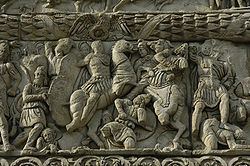Unknown Unknown Location Basean | Start date 298 AD | |
 | ||
Unknown Unknown, probably very heavy Similar Roman–Persian Wars, Battle of Resaena, Battle of Samarra, Anastasian War | ||
Battle of satala 298
The Battle of Satala was fought in 298, in Armenia, between the forces of the Roman Empire under the Tetrarch Galerius and the forces of the Sassanid Persian ruler Narseh (Narses). The battle was an overwhelming victory for the Roman army, with the Persian army destroyed as a fighting force.
Contents
Battle of satala 530
Location
Though traditionally known as the Battle of Satala, the precise location of the battle is not known; the town of Satala may have served as the Roman base of operations. In an early Armenian history it is stated that the battle was fought in the region of Basean, at a village called Osxay. Basean (Phasiana) is usually placed to the east of Erzerum.
Background
In 295 or 296, Narseh declared war on Rome. He appears to have first invaded western Armenia, retaking the lands delivered to King Tiridates III of Armenia in the peace of 287. Narseh then moved south into Roman Mesopotamia, where he inflicted a severe defeat on Galerius, then commander of the Eastern forces, in the region between Carrhae (Harran, Turkey) and Callinicum (Raqqa, Syria).
Galerius had been reinforced, probably in the spring of 298, by a new contingent collected from the empire's best recruiting grounds in Illyricum. Narseh did not advance from Armenia and Mesopotamia, allowing Galerius to take the offensive in 298 with an attack on northern Mesopotamia via Armenia. Narseh withdrew his army into Armenia, which would ensure that Galerius could not move south to attack the Persian capital, Ctesiphon, as it would expose his communications, and nearby Roman provinces, to attack. However, this strategic move was to Narseh's tactical disadvantage: the rugged Armenian terrain was favourable to the Roman army, whose strength was its infantry, but was unfavourable to cavalry operations, in which the Sassanid army excelled. Galerius entered Armenia in company with King Tiridates. Local aid also gave the Romans the advantage of surprise over the Persian forces, and, in two successive battles, Galerius secured victories over Narseh.
Battle
During the second encounter, the Battle of Satala, the Roman forces seized Narseh's camp, his treasury, his harem, and his wife. Detailed descriptions of the dispositions of the two armies have not survived, but it is obvious that the Roman army caught the Persians unprepared whilst encamped. Presumably, the active aid of the local Armenian population allowed the Romans to approach and trap the Persians without being detected.
According to the account of Faustus of Byzantium (in Armenian: P'awstos Buzand):
"[The Romans] came and attacked the army of the king of Iran encamped in that same place [Osxay], finding them negligently unconcerned and unsuspectingly at rest. Attacking during the daytime, they fell upon the Iranian king, putting everything to the sword and sparing no one. Then they took the banak [mobile royal treasury?] as loot, the king's women, the bambish [queen of queens] and the women with her their possessions and goods into captivity — their women and treasures, provisions and equipage. Only the king was able to escape by a hairsbreadth and go free as a fugitive, thanks to a swift running pony."
Narseh was himself wounded in the battle and fled Armenia into the Persian heartland, presumably in the hope of raising more troops; the booty taken by the victors was so great that it achieved legendary status and its transport back to Roman territory posed a logistical challenge. The battle was the origin of a well known anecdote, related by the historian Ammianus Marcellinus, that a simple Roman soldier had looted a highly decorated leather bag filled with pearls from the Persians; the soldier threw away the pearls as useless, but kept the bag.
Narseh's wife would live out the remainder of the war in Daphne, a suburb of Antioch, serving as a constant reminder to the Persians of the Roman victory. Galerius advanced into Media and Adiabene, winning continuous victories, most prominently near Resaina (Ras al-Ayn), and securing Nisibis (Nusaybin) before 1 October 298. He moved down the Tigris, taking Ctesiphon, and gazing onwards to the ruins of Babylon before returning to Roman territory via the Euphrates.
Aftermath
The battle was followed by the Treaty of Nisibis, highly advantageous to Rome. It ended the Roman–Sassanid war; Tiridates was restored to his throne in Armenia as a Roman vassal, and the Georgian Kingdom of Iberia was acknowledged as also falling under Roman authority. Rome itself received a part of Upper Mesopotamia that extended even beyond the Tigris - including the cities of Tigranokert, Saird, Martyropolis, Balalesa, Moxos, Daudia, and Arzan. Peace was thus assured for some decades until its collapse with the military resurgence of Persia under Shapur II in the 330s.
